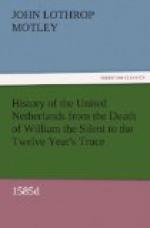“Necessity has forced Antwerp,” he wrote on the 17th of August—the very day on which the capitulation was actually signed—“to enter into negotiation. I understand the artifice of Aldegonde in seeking to prolong and make difficult the whole affair, under pretext of treating for the reduction of Holland and Zeeland at the same time. It was therefore very adroit in you to defeat this joint scheme at once, and urge the Antwerp matter by itself, at the same time not shutting the door on the others. With the prudence and dexterity with which this business has thus far been managed I am thoroughly satisfied.”
The King also expressed his gratification at hearing from Parma that the demand for religious liberty in the Netherlands would soon be abandoned.
“In spite of the vehemence,” he said, “which they manifest in the religious matter, desiring some kind of liberty, they will in the end, as you say they will, content themselves with what the other cities, which have returned to obedience, have obtained. This must be done in all cases without flinching, and without permitting any modification.”
What “had been obtained” by Brussels, Mechlin, Ghent, was well known. The heretics had obtained the choice of renouncing their religion or of going into perpetual exile, and this was to be the case “without flinching” in Holland and Zeeland, if those provinces chose to return to obedience. Yet Sainte Aldegonde deluded himself with the thought of a religious peace.
In another and very important letter of the same date Philip laid down his policy very distinctly. The Prince of Parma, by no means such a bigot as his master, had hinted at the possibility of tolerating the reformed religion in the places recovered from the rebels, sub silentio, for a period not defined, and long enough for the heretics to awake from their errors.
“You have got an expression of opinion, I see,” wrote the King to Alexander, “of some grave men of wisdom and conscience, that the limitation of time, during which the heretics may live without scandal, may be left undefined; but I feel very keenly the danger of such a proposition. With regard to Holland and Zeeland, or any other provinces or towns, the first step must be for them to receive and maintain alone the exercise of the Catholic religion, and to subject themselves to the Roman church, without tolerating the exercise of any other religion, in city, village, farm-house, or building thereto destined in the fields, or in any place whatsoever; and in this regulation there is to be no flaw, no change, no concession by convention or otherwise of a religious peace, or anything of the sort. They are all to embrace the Roman Catholic religion, and the exercise of that is alone to be permitted.”
This certainly was distinct enough, and nothing had been ever said in public to induce a belief in any modification of the principles on which Philip had uniformly acted. That monarch considered himself born to suppress heresy, and he had certainly been carrying out this work during his whole lifetime.




